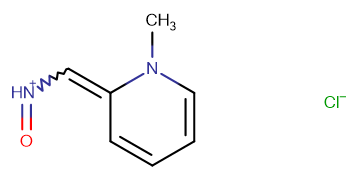
2-Pyridinealdoxime methochloride
CAS No. 51-15-0
2-Pyridinealdoxime methochloride ( 2-PAM )
Catalog No. M14766 CAS No. 51-15-0
Pralidoxime chloride is a useful agent in the treatment of organophosphate poisoning.
Purity : >98%(HPLC)
 COA
COA
 Datasheet
Datasheet
 HNMR
HNMR
 HPLC
HPLC
 MSDS
MSDS
 Handing Instructions
Handing Instructions
| Size | Price / USD | Stock | Quantity |
| 50MG | 32 | In Stock |


|
| 100MG | 45 | In Stock |


|
| 200MG | 61 | In Stock |


|
| 500MG | Get Quote | In Stock |


|
| 1G | Get Quote | In Stock |


|
Biological Information
-
Product Name2-Pyridinealdoxime methochloride
-
NoteResearch use only, not for human use.
-
Brief DescriptionPralidoxime chloride is a useful agent in the treatment of organophosphate poisoning.
-
DescriptionPralidoxime chloride is a useful agent in the treatment of organophosphate poisoning. Pralidoxime binds to organophosphate-inactivated acetylcholinesterase, used to combat poisoning by organophosphates or acetylcholinesterase inhibitors (nerve agents) in conjunction with atropine and diazepam.
-
Synonyms2-PAM
-
PathwayEndocrinology/Hormones
-
TargetAChR
-
RecptorAchE
-
Research AreaNeurological Disease
-
Indication——
Chemical Information
-
CAS Number51-15-0
-
Formula Weight172.61
-
Molecular FormulaC7H9ClN2O
-
Purity>98%(HPLC)
-
SolubilityDMSO: 10 mM
-
SMILESCN1C=CC=CC1=C[NH+]=O.[Cl-]
-
Chemical Name[(E)-(1-methylpyridin-2-ylidene)methyl]-oxoazanium;chloride
Shipping & Storage Information
-
Storage(-20℃)
-
ShippingWith Ice Pack
-
Stability≥ 2 years
Reference
1.Jokanovi M, Prostran M. Curr Med Chem. 2009;16(17):2177-88.
molnova catalog


related products
-
α-Conotoxin AuIB
Selective antagonist of α3β4 nicotinic acetylcholine receptors. Displays > 100-fold selectivity over other receptor subunit combinations including α2β2, α2β4, α3β2, α4β2, α4β4 and α1β1γδ.
-
Tacrine hydrochlorid...
A cholinesterase inhibitor that crosses the blood-brain barrier.
-
GZD 824
GZD824 is an orally bioavailable Bcr-Abl inhibitor for Bcr-Abl(WT, IC50: 0.34 nM) and Bcr-Abl(T315I, IC50: 0.68 nM).



 Cart
Cart
 sales@molnova.com
sales@molnova.com


